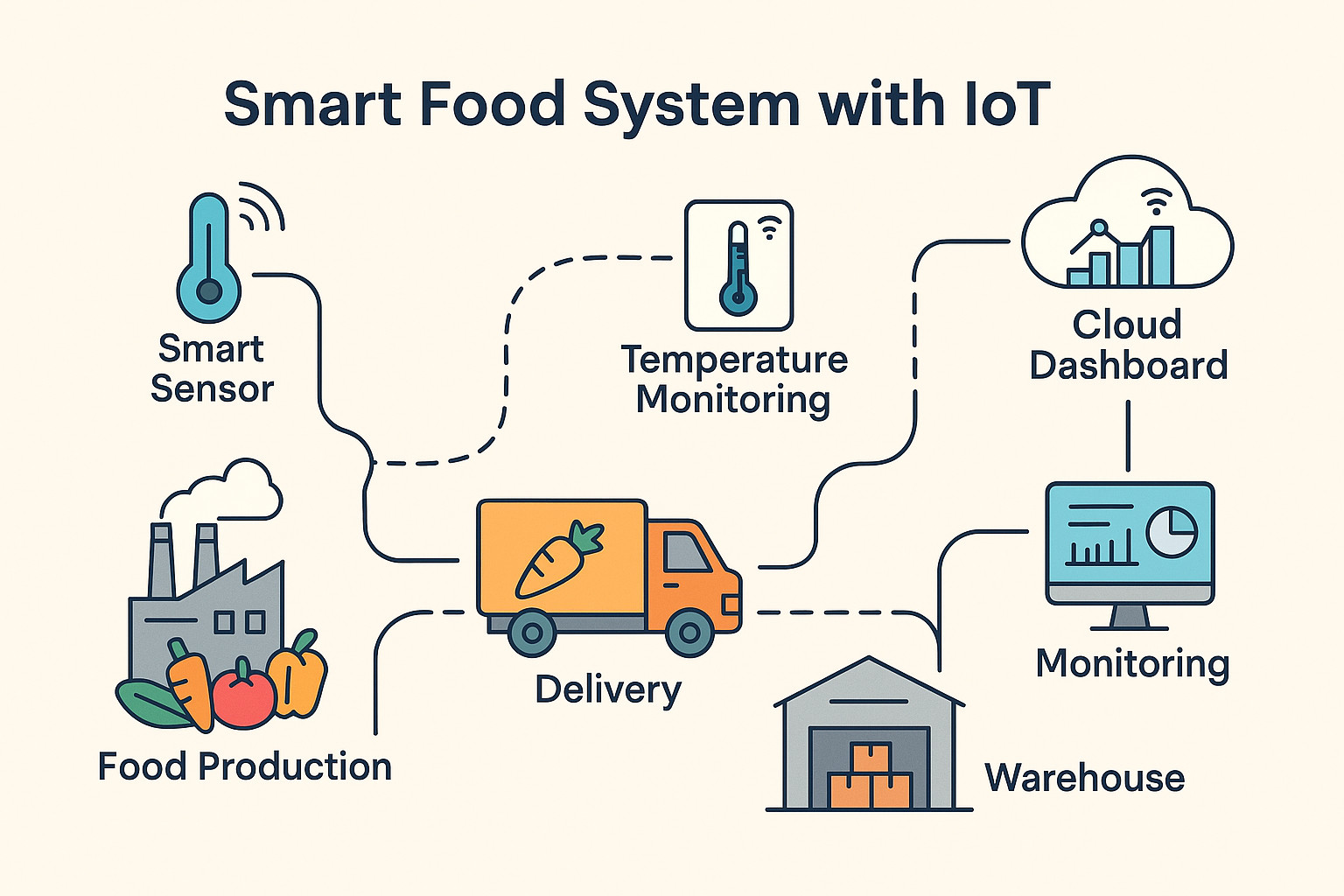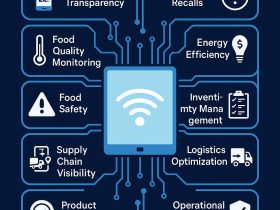IoT in Food and Beverage Industry- Benefits, Applications, & Future Trends
[joli-toc
Introduction to IoT in Food and beverage Industry
The global food and beverage (F&B) industry is undergoing a technological renaissance, driven by rising consumer demands, increasing safety standards, and the digital transformation of supply chains. At the heart of this revolution is the Internet of Things (IoT) — a technology ecosystem that uses connected devices, sensors, and analytics to provide real-time visibility and control across the entire food lifecycle.
IoT is reshaping the food sector—from precision agriculture and processing to storage, logistics, retail, and customer experience. This article dives deep into how IoT is transforming the food and beverage industry, the advantages it brings, real-world applications, and what the future holds.
1. Understanding Food Technology and the Role of IoT
Food technology is the science behind the processing, preservation, and distribution of food. Over the last decade, the integration of digital innovations—especially IoT—has taken this field to a whole new level.
The Internet of Things enables communication between machines, objects, and people using internet-connected devices. In the F&B sector, IoT provides the ability to collect, transmit, and analyze data throughout every stage of the food chain. It supports:
- Real-time tracking
- Remote monitoring
- Predictive maintenance
- Process automation
- Data-driven decision-making
2. How IoT Enhances the Food Supply Chain
One of the most profound impacts of IoT is in supply chain management, particularly in the food sector where freshness, hygiene, and timing are critical.
Key Applications in the Food Supply Chain:
| Stage | IoT Functionality |
|---|---|
| Farm Production | Soil moisture, weather, crop health sensors |
| Processing Units | Automated processing lines, quality control alerts |
| Cold Storage | Temperature/humidity sensors, energy optimization |
| Transport & Delivery | GPS tracking, cold chain monitoring, route optimization |
| Retail Stores | Smart shelves, inventory monitoring, customer analytics |
3. Benefits of IoT in the Food and Beverage Industry
Let’s explore the tangible benefits businesses can gain from IoT adoption:
a. Food Safety and Compliance
IoT devices monitor temperature, hygiene, and contamination risks, ensuring food stays within regulatory standards throughout its journey. Sensors in cold storage units, trucks, and display cases provide instant alerts if thresholds are breached.
b. Reduction in Food Waste
A significant amount of food waste occurs due to spoilage in storage or transit. With IoT, companies can detect abnormalities early—such as a sudden temperature spike in a refrigerated truck—and take corrective action before it’s too late.
c. Real-Time Inventory Management
Smart inventory systems use RFID tags and IoT sensors to track inventory levels, expiration dates, and demand patterns in real-time. This helps businesses reduce overstocking or understocking and optimize inventory turnover.
d. Cost Savings and Higher ROI
IoT reduces manual labor, minimizes losses due to spoilage, and automates processes—leading to lower operational costs and increased profitability. Companies using IoT report up to 25% in logistics cost reductions.
e. Enhanced Customer Satisfaction
With improved food safety, transparency, and delivery speed, customers enjoy better quality products and greater trust in brands. Some companies even let customers scan QR codes to see where and how their food was sourced and handled.
4. Real-World Use Cases of IoT in the F&B Sector
a. Farm to Fork Transparency
Companies like IBM and Walmart use blockchain + IoT to trace food from farms to stores. This allows for faster food recalls, improved accountability, and reduced fraud.
b. Cold Chain Monitoring
Dairy and meat industries rely heavily on refrigeration. IoT sensors track temperature fluctuations throughout the cold chain, ensuring perishables stay fresh and safe.
c. Smart Vending and Retail
IoT-equipped vending machines can monitor stock levels and customer preferences, reordering products automatically. Retailers use smart shelves to adjust pricing based on shelf life and demand.
d. Fleet Management
IoT-powered GPS and telematics systems enable real-time vehicle tracking, fuel management, and delivery route optimization, reducing delays and enhancing efficiency.
5. Challenges in IoT Adoption for Food Businesses
While the advantages are clear, several roadblocks need to be addressed:
a. Infrastructure Barriers
Smaller businesses and rural producers often lack access to reliable internet connectivity, modern devices, or cloud-based systems.
b. Data Security & Privacy
Handling large amounts of sensitive data makes companies vulnerable to cyberattacks and data breaches. IoT networks must be built with strong encryption and security protocols.
c. High Initial Investment
Deploying a comprehensive IoT system requires hardware, software, integration, and training. Although ROI is positive in the long term, the short-term costs may deter some businesses.
d. Integration with Legacy Systems
Many food manufacturers still operate on outdated systems. Integrating IoT with legacy ERP or machinery systems can be technically complex and time-consuming.
6. Future Trends of IoT in the Food Industry
The coming years will see even more advanced use of IoT in food production and delivery:
- AI-Driven Predictive Maintenance: Machines alert operators before a breakdown occurs.
- Robotics + IoT: Automated systems for packaging, quality inspection, and delivery.
- Blockchain for Full Traceability: From seed to shelf, with immutable records.
- Personalized Nutrition: IoT wearables suggest foods based on user health data.
- Dynamic Pricing: Prices auto-adjust based on freshness, shelf life, or stock levels.
7. Developed vs. Developing Nations: The Global Adoption Gap
Developed countries like the USA, UK, and Japan are already deploying full-scale IoT ecosystems in their food industries. Developing nations are catching up, driven by:
- Rising smartphone/internet penetration
- Government-supported digital infrastructure programs
- Local startups innovating in agri-tech and smart logistics
Over time, these nations will not only adopt but leapfrog in innovation due to mobile-first and cost-efficient solutions.
Conclusion
The Internet of Things is no longer a futuristic concept—it is a present-day solution to many of the challenges in the food and beverage industry. From minimizing waste to improving food safety and maximizing profit margins, IoT provides a strategic advantage for businesses that embrace it.
Though challenges exist, the long-term gains are immense. Smart food systems powered by IoT are the future of a safer, more sustainable, and consumer-centric food industry.
See also: What is Precision Agriculture?-Impact of Precision Agriculture in India
Get Involved!
What do you think about the role of “IoT in the food and beverage industry” Share your insights in the comments!
Subscribe to our YouTube Channel for practical IoT tutorials and industry case studies.









Leave a Review